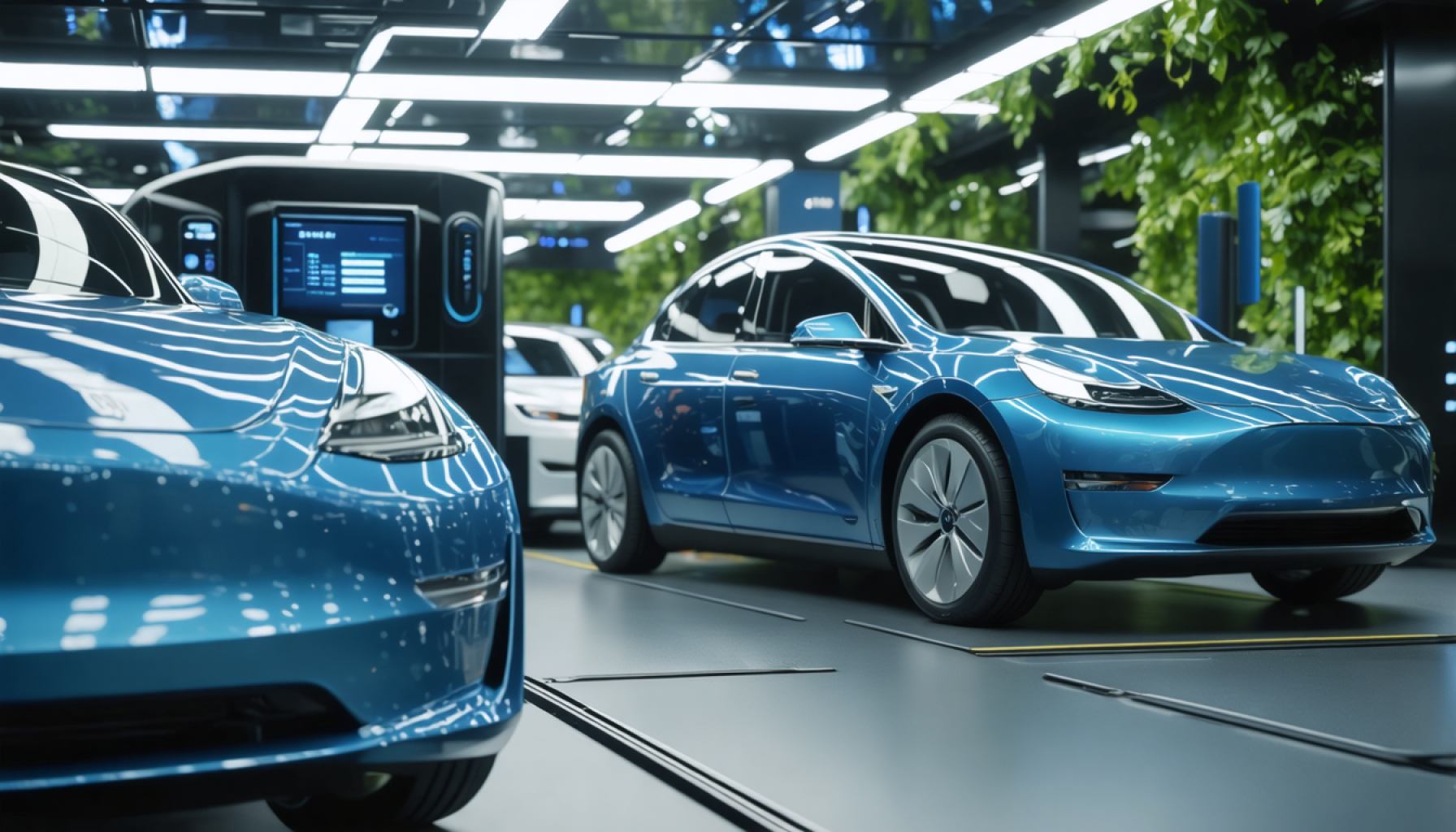- The electric vehicle (EV) revolution is transforming urban soundscapes with quieter, eco-friendly transportation solutions driven by advancements in EV batteries.
- The global EV battery market is projected to grow from $99.38 billion in 2025 to $224.55 billion by 2034, significantly impacting automotive manufacturers and economies.
- Advancements in charging infrastructure and global urbanization trends are making EV adoption more feasible and necessary.
- Lithium-ion batteries are essential to this transformation, offering high energy density and efficiency for longer driving ranges and quicker charging times.
- Key companies like LG Energy Solution, Panasonic, and Samsung SDI are enhancing battery performance and reducing costs, with natural graphite playing a crucial role in anode manufacturing.
- Asia Pacific leads in EV production, with significant contributions from Europe and North America towards greener mobility through investments and regulations.
- EV batteries are pivotal in driving sustainable transportation and the evolution of city ecosystems, signaling a shift towards a cleaner future.
Imagine a world where the vibrant hum of city streets is not overpowered by the roar of engines but accompanied by the soft whir of electric vehicles (EVs). This quiet shift in soundscape is more than just a change in atmosphere; it’s the pulse of a revolution driven by the evolution and proliferation of electric vehicle batteries.
As urban landscapes continue their relentless expansion and densification, the demand for eco-friendly transportation solutions surges forward like a tide. The heart of this transformation lies in the rapidly growing global EV battery market, which is projected to burgeon from $99.38 billion in 2025 to an astonishing $224.55 billion by 2034. This growth trajectory is electrifying not only automotive manufacturers but entire economies worldwide.
Crucial advancements in charging infrastructure are making the adoption of EVs more feasible, as charging stations become staples across urban settings much like gas stations once did. Coupled with global urbanization trends, where cities stretch out into sprawling megacities, the necessity for sustainable, zero-emission vehicles becomes undeniable.
Yet, the real heroes of this narrative are the meticulously engineered lithium-ion batteries that have positioned themselves at the forefront of this automotive metamorphosis. These powerhouses of energy offer high energy density and efficiency, translating into longer driving ranges and quicker charging times. Within these compact cells, a symphony of chemistry unfolds: lithium ions dance between anode and cathode, orchestrating the flow of electricity with precision and grace.
Driving innovation even further are the strides in battery chemistry and manufacturing efficiency. Companies like LG Energy Solution, Panasonic, and Samsung SDI are relentlessly pushing boundaries, enhancing battery performance while reducing costs. Their efforts are bolstered by advancements in battery materials, with natural graphite poised to become a star player in anode manufacturing.
Geographically, Asia Pacific reigns supreme as the powerhouse of EV production, with China leading the charge. Meanwhile, Europe and North America are not far behind, investing heavily in green initiatives and stringent emission regulations. This collective global push is setting the stage for an era of cleaner, greener mobility.
The takeaway is clear: as the gears of the automotive industry shift toward electrification, the role of EV batteries becomes pivotal. They are the pulse of progress, propelling us towards a future where transportation is sustainable and our cities breathe easier. The electric vehicle battery market is not just growing; it’s charging into a new era of transportation, leading the charge towards a more sustainable future.
In the age of electric mobility, these batteries are not just powering vehicles; they’re driving the evolution of entire ecosystems. So, next time an EV whizzes past, remember, it’s not just a car—it’s the whisper of a revolution, fueled by innovation and the urgent need for change.
The Electric Vehicle Battery Revolution: Unveiling the Future of Sustainable Transportation
Introduction
The transition to electric vehicles (EVs) is transforming cityscapes worldwide, driven by the advancement of electric vehicle batteries. This shift is crucial for sustainable urban growth, reducing emissions, and enhancing the quality of life. The global electric vehicle battery market is projected to grow from $99.38 billion in 2025 to $224.55 billion by 2034, signifying the massive impact of this technological revolution.
How EV Battery Technology is Revolutionizing Transportation
1. Battery Chemistry and Efficiency: Lithium-ion batteries dominate the market due to their high energy density and efficiency. Continuous innovations in battery chemistry are enhancing performance and reducing costs, making EVs more accessible to consumers.
2. Infrastructure Development: The expansion of charging infrastructure is critical to the feasibility of EVs. As more charging stations are integrated into urban landscapes, they become as ubiquitous as traditional gas stations, facilitating the shift to electric vehicles.
3. Key Players and Innovations: Companies like LG Energy Solution, Panasonic, and Samsung SDI are at the forefront of battery innovation, working on improving battery life, charging speed, and affordability. The use of natural graphite in anode manufacturing is one such advancement expected to play a significant role.
4. Geographical Trends: The Asia Pacific region, led by China, is a major hub for EV production. However, Europe and North America are catching up quickly, investing heavily in green technologies and stringent emission standards.
Insights & Predictions
– Market Expansion: As the demand for EVs increases, the market for lithium-ion batteries and alternative energy solutions will continue to grow, driving advancements in battery recycling and second-life applications.
– Technological Breakthroughs: Future innovations may include solid-state batteries, which promise even higher energy density and safety, potentially revolutionizing the sector further.
– Policy and Regulation: Governments worldwide are enforcing stricter regulations to reduce carbon footprints, accelerating the shift from fossil-fuel-powered vehicles to EVs.
Pros & Cons Overview
Pros
– Reduced greenhouse gas emissions
– Lower operating and maintenance costs
– Enhanced energy security through reduced reliance on oil
Cons
– Initial purchase cost can be higher compared to traditional vehicles
– Limited charging infrastructure in some regions
– Battery disposal and recycling challenges
Recent Controversies & Limitations
– Supply Chain Concerns: The sourcing of raw materials like lithium and cobalt raises ethical and environmental concerns.
– Battery Degradation: Over time, lithium-ion batteries can degrade, leading to reduced efficiency and driving ranges—an area still under improvement.
Actionable Recommendations
– For Consumers: When considering purchasing an EV, research the model’s battery life, warranty, and available charging infrastructure in your area.
– For Policymakers: Invest in expanding charging infrastructure and incentivize research into sustainable battery disposal and recycling practices.
– For Manufacturers: Focus on innovative materials and methods to enhance battery performance while reducing costs and environmental impacts.
Quick Tips
– Plan your route to include charging stations during long-distance travel with an EV.
– Regularly check battery health to maintain performance and longevity.
– Stay informed about the latest developments in battery technology and market trends.
Conclusion
The electric vehicle battery market is poised for exponential growth as it leads the transformation toward a more sustainable future. With ongoing advancements in technology and infrastructure, the dream of eco-friendly urban transportation is becoming a reality. For more insights and updates on sustainable technology, visit Tesla’s website or Nissan Global.







